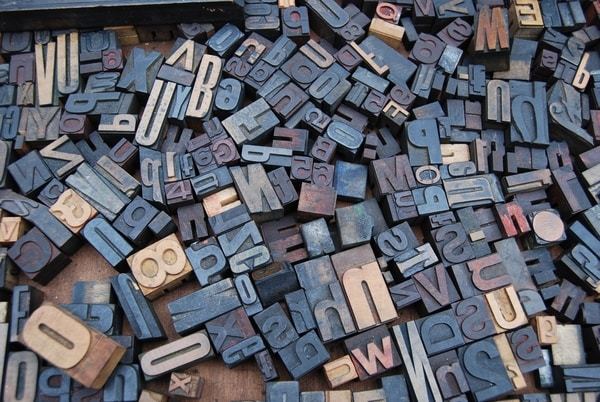Typeface designers and font creators who wish to protect their work from plagiarism will find that the intellectual property laws for typographic design differ slightly from laws geared toward writers. Copyrights, patents, and trademarks are some of the ways in which type designers protect their work from plagiarism. Before I discuss these, however, I want to clarify the definitions of font and typeface. A font is the code that creates the type design on a computer screen, and a typeface is a collection of characters. Although these terms are often used interchangeably, the distinction matters for the intellectual property laws that surround typographic design.
Now, let’s look at copyright. On the website of the US Copyright Office, under definitions of what can be subject to protection, the closest category that a typeface might fall into is the section on pictorial, graphic, and sculptural works. A typeface fulfills the first half of the section’s requirement as a “two-dimensional and three-dimensional work of fine, graphic, and applied art” but doesn’t meet the second half of the requirements. This is where it’s stated that the design must “include works of artistic craftsmanship insofar as their form but not their mechanical or utilitarian aspects”; in other words, only the aesthetic elements of a design piece will be subject to copyright. In order to qualify for copyright protection under the section I listed above, a designer’s work must be “identified separately from, and [be] capable of existing independently of, the utilitarian aspects,” which makes it impossible for typeface to use this section of the law. A typeface uses the alphabet as the basis of its design, and this is a utilitarian aspect that is impossible to separate from the type design. Attempting to separate the two might just leave the flourishes and a few serifs in the “artistic” category. For that reason (and various others), typeface in and of itself is not subject to copyright.
However, the computer programs that create the typeface on a screen can still be copyrighted. Even if the output—the typeface—can’t be copyrighted, the code that creates it can be. At the same time, others can still draw “inspiration” from a typeface and attempt to recreate the code.
Trademark is Robert Bringhurst’s first choice in intellectual property law against plagiarism of typeface. The author of The Elements of Typographic Style believes registering a typeface under trademark will protect the brand of the design because it forces imitators to use another name. He highlights how odd it is to protect the title of a work when usually in the publishing industry it is the content that matters, but typeface has faced challenges and will likely continue to do so. Trademarks need to be renewed every ten years.
Other methods of protection from typeface plagiarism are utility and design patents. According to the US Patent and Trademark Office, in order to obtain a utility patent the creator must invent “…any new and useful process, machine, manufacture, or composition of matter, or any new and useful improvement thereof.” This means that if a designer wishes to patent a font, the design must be an arguably useful improvement on the characters used in communication. The design could be defended on the grounds that it is more modern, that it gives a better sense of feeling, or that it helps with readability. However, the requirement of “novelty and non-obviousness” restricts the protection offered to font programs. This requirement means that the design must be a new invention; it needs to be a font program, which is something the everyday person doesn’t see when they read a sign, a book, or a typographic logo. Utility patents last for twenty years, whereas design patents last for fourteen years.
So, if you’re a font creator or a typeface designer hoping to protect your work from plagiarism, you might want to consider using more than one of the intellectual property laws after reading about some of their limitations.

